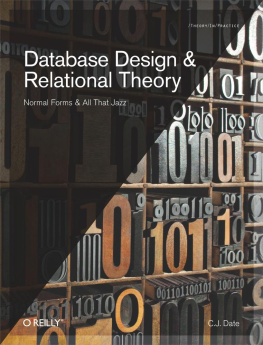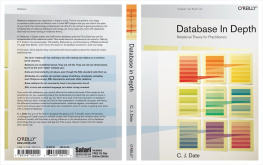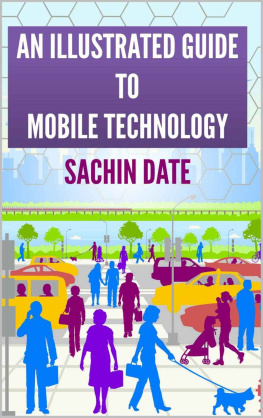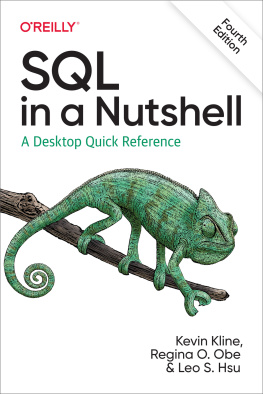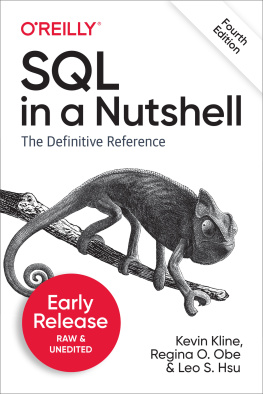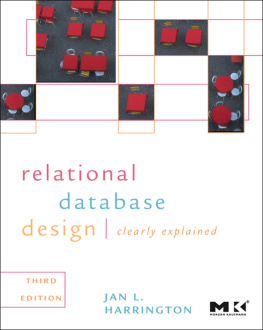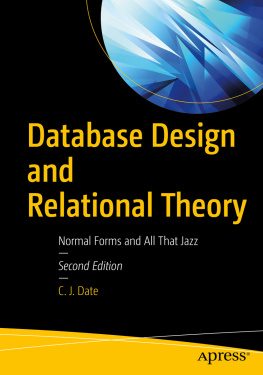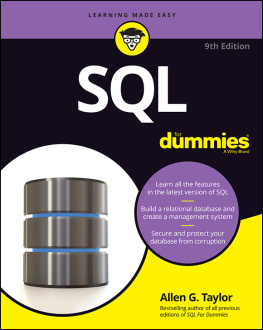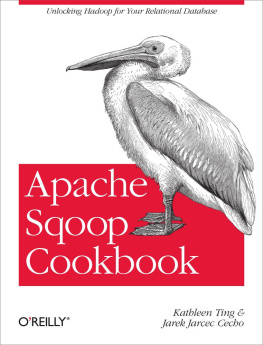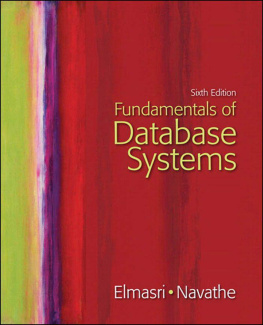Contents
The New Relational Database Dictionary
A comprehensive glossary of concepts arising in connection with the relational model of data, with definitions and illustrative examples
C. J. Date
The New Relational Database Dictionary
by C. J. Date
Copyright 2016 C. J. Date. All rights reserved.
Printed in the United States of America.
Published by OReilly Media, Inc.,
1005 Gravenstein Highway North, Sebastopol, CA 95472
OReilly books may be purchased for educational, business, or sales promotional use. Online editions are also available for most titles (.
Revision History:
2015-12-15 First release.
See http://oreilly.com/catalog/errata.csp?isbn=9781491951736 for release details.
Nutshell Handbook, the Nutshell Handbook logo, and the OReilly logo are registered trademarks of OReilly Media, Inc. The New Relational Database Dictionary and related trade dress are trademarks of OReilly Media, Inc.
Many of the designations used by manufacturers and sellers to distinguish their products are claimed as trademarks. Where those designations appear in this book, and OReilly Media, Inc., was aware of a trademark claim, the designations have been printed in caps or initial caps.
While every precaution has been taken in the preparation of this book, the publisher and author assume no responsibility for errors or omissions, or for damages resulting from the use of the information contained herein.
ISBN: 978-1-491-95173-6
[LSI]
Thy gift, thy tables, are within my brain
Full charactered with lasting memory,
Which shall above that idle rank remain
Beyond all date, even to eternity.
William Shakespeare: Sonnet 122
When I use a word, Humpty Dumpty said, in rather a scornful tone, it means just what I choose it to meanneither more nor less.
Lewis Carroll: Through the Looking-Glass and What Alice Found There
Myself when young did eagerly frequent
Doctor and Saint, and heard great Argument
About it and about; but evermore
Came out by the same Door as in I went.
Edward Fitzgerald: The Rubiyt of Omar Khayyam
Lexicographer A writer of dictionaries, a harmless drudge
Dr Johnson: A Dictionary of the English Language
To all keepers of the true relational flame
About the Author
C. J. Date is an independent author, lecturer, researcher, and consultant, specializing in relational database technology. He is best known for his book An Introduction to Database Systems (8th edition, Addison-Wesley, 2004), which has sold some 900,000 copies at the time of writing and is used in several hundred colleges and universities worldwide. He is also the author of many other books on database management, the following among them:
From Addison-Wesley: Databases, Types, and the Relational Model: The Third Manifesto (3rd edition, with Hugh Darwen, 2007)
From Trafford: Logic and Databases: The Roots of Relational Theory (2007) and Database Explorations: Essays on The Third Manifesto and Related Topics (with Hugh Darwen, 2010)
From Ventus: Go Faster! The TransRelationalTM Approach to DBMS Implementation (2002, 2011)
From OReilly: Database Design and RelationalTheory: Normal Forms and All That Jazz (2012); View Updating and Relational Theory: Solving the View Update Problem (2013); Relational Theory for Computer Professionals: What Relational Databases Are Really All About (2013); and SQL and Relational Theory: How to Write Accurate SQL Code (3rd edition, 2015)
From Morgan Kaufmann: Time and Relational Theory: Temporal Data in the Relational Model and SQL (with Hugh Darwen and Nikos A. Lorentzos, 2014)
Mr. Date was inducted into the Computing Industry Hall of Fame in 2004. He enjoys a reputation that is second to none for his ability to explain complex technical subjects in a clear and understandable fashion.
Introduction
This dictionary contains over 1,700 entries dealing with issues, terms, and concepts involved in, or arising from use of, the relational model of data. Most of the entries include not only a definition as suchoften several definitions, in factbut also an illustrative example (sometimes more than one). Whats more, Ive tried to make those entries as clear, precise, and accurate as I can; theyre based on my own best understanding of the material, an understanding Ive gradually been honing over some 45 years of involvement in this field.
Id also like to stress the fact that the dictionary is, as advertised, relational. To that end, Ive deliberately omitted many topics that are only tangentially connected to relational databases as such (in particular, topics that have to do with database technology in general, as opposed to relational databases specifically); for example, I have little or nothing to say about security, recovery, or concurrency matters. Ive also omitted certain SQL topics thatdespite the fact that SQL is supposed to be a relational languagearent really relational at all (cursors, outer join, and SQLs various retain duplicates options are examples here). At the same time, Ive deliberately included a few nonrelational topics in order to make it clear that, contrary to popular opinion, the topics in question are indeed nonrelational (index is a case in point here).
I must explain too that this is a dictionary with an attitude. Its my very firm belief that the relational model is the right and proper foundation for database technology and will remain so for as far out as anyone can see, and many of the definitions in what follows reflect this belief. As I said in my book SQL and Relational Theory: How to Write Accurate SQL Code (3rd edition, OReilly Media Inc., 2015):
In my opinion, the relational model is rock solid, and right, and will endure. A hundred years from now, I fully expect database systems still to be based on Codds relational model. Why? Because the foundations of that modelnamely, set theory and predicate logicare themselves rock solid in turn. Elements of predicate logic in particular go back well over 2000 years, at least as far as Aristotle (384322 BCE).
Partly as a consequence of this state of affairs, I havent hesitated to mark some term or concept as deprecated if I believe there are good reasons to avoid it, even if the term or concept in question is in widespread use at the time of writing. Materialized view is a case in point here.
The Suppliers-and-Parts Database
Many of the examples used to illustrate the definitions are based on the familiar (not to say hackneyed) suppliers-and-parts database. I apologize for dragging out this old warhorse yet one more time, but as Ive said many times before, I believe that using the same exampleor essentially the same example, at any ratein a variety of different publications can be a help, not a hindrance, in learning. Here are the relvar definitions for that database (and if you dont know what a relvar is, then please see the pertinent dictionary entry!):



